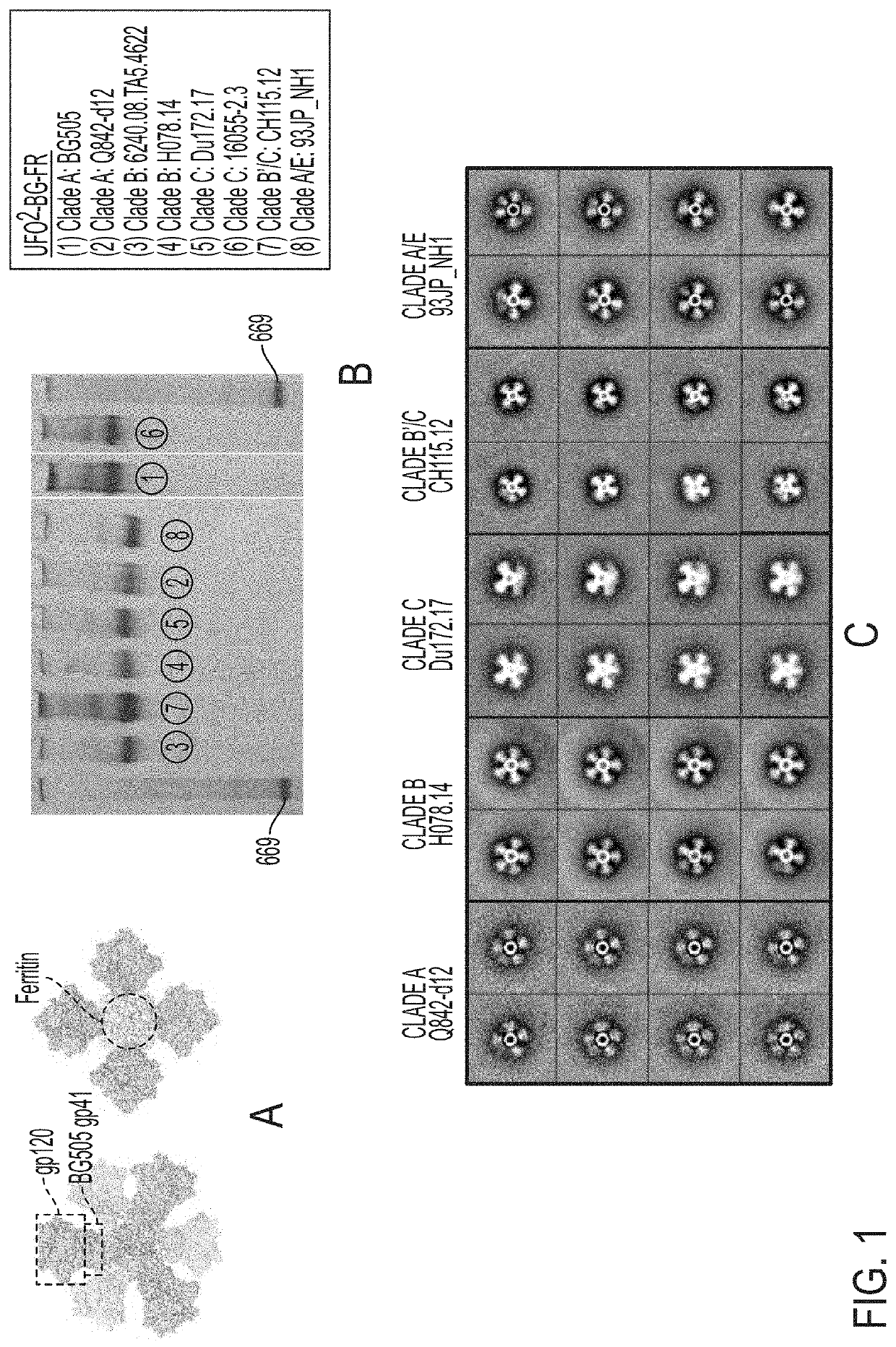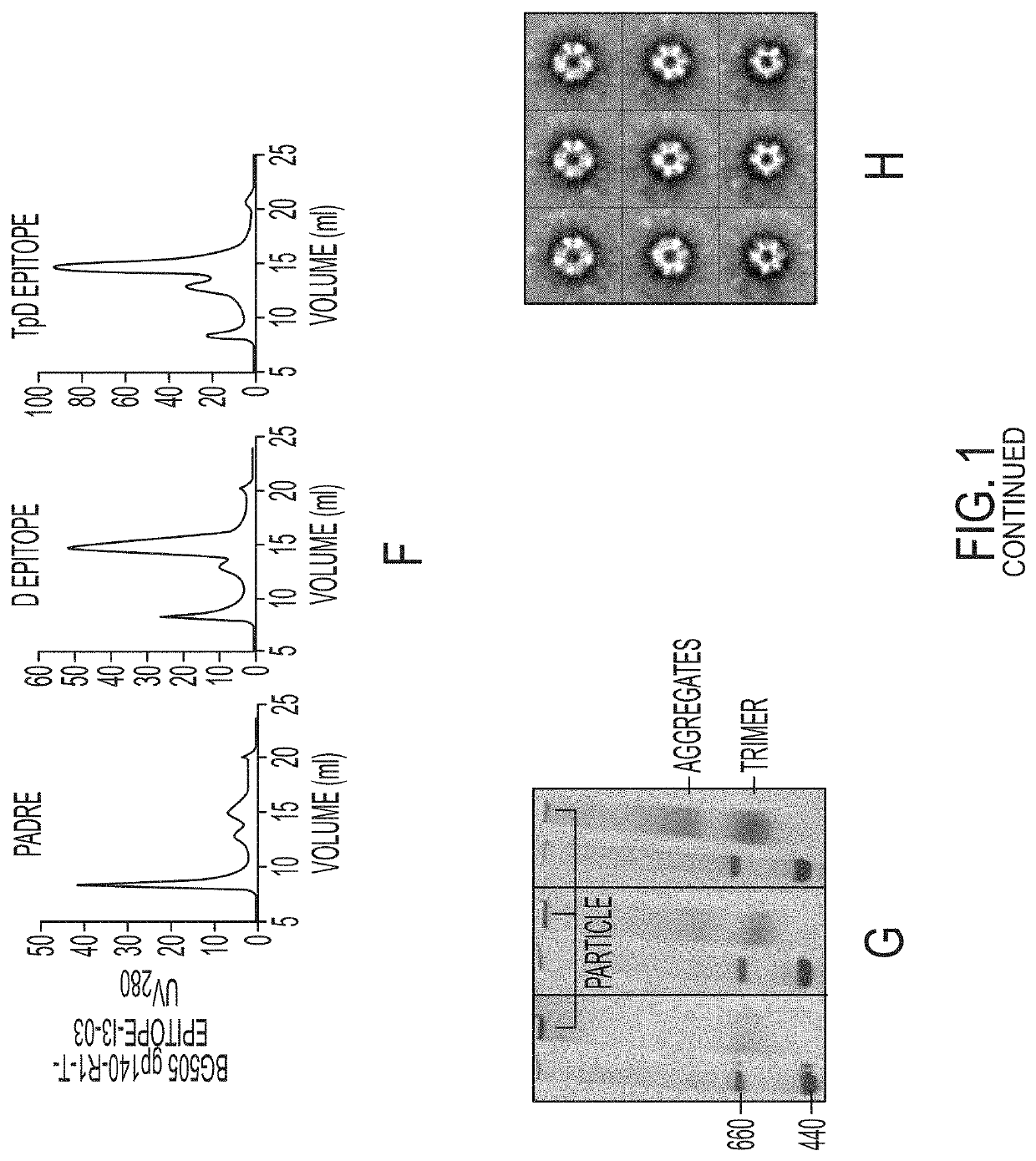Novel Scaffolded HIV-1 Vaccine Immunogens
a scaffolded, hiv-1 vaccine technology, applied in the direction of antibody medical ingredients, peptide/protein ingredients, peptide sources, etc., can solve the problems that the utility of nanoparticles as carriers to display native-like trimers has not been rigorously explored in hiv-1 vaccine development, and may not be the optimal form of gp140 trimer, etc., to promote fusion immunogen recognition and stabilize the nanoparticle structure
- Summary
- Abstract
- Description
- Claims
- Application Information
AI Technical Summary
Benefits of technology
Problems solved by technology
Method used
Image
Examples
example 1
Design and Characterization of UFO2-BG Trimers
[0069]A major obstacle faced by current trimer designs is the deterioration of yield, purity, and stability once they are extended from BG505 to other strains. The solutions proposed thus far include (1) purification methods aimed to separate native-like trimers from misfolded Env proteins, such as bNAb affinity columns, negative selection, multi-cycle SEC, and a combined chromatographic approach; and (2) auxiliary mutations informed by atomic structures or derived from library screening. However, these solutions are empirical by nature and often result in suboptimal outcomes such as reduced trimer yield and unexpected change in Env properties. We previously identified an HR1 bend (residues 547-569) as the primary cause of Env metastability (Kong et al., Nat. Comm. 7, 12040, 2016). Rational redesign of this structurally strained region in gp41ECTO significantly improved trimer yield and purity for multiple HIV-1 strains, yet still produc...
example 2
Nanoparticle Presentation of UFO2-BG Trimers from Diverse Subtypes
[0072]Following our previously reported design strategy (He et al., Nat. Comm. 7, 12041, 2016), we investigated whether the UFO2-BG trimers derived from diverse HIV-1 strains can be displayed on the 24-meric ferritin (FR) nanoparticle. We hypothesize that BG505 gp41ECTO of the UFO design can facilitate both gp140 trimerization and nanoparticle assembly (FIG. 1A). To test this hypothesis, we designed eight UFO2-BG-FR constructs with the C terminus of gp41ECTO (residue 664) fused to the N terminus (Asp5) of a ferritin subunit. The resulting fusion constructs were expressed transiently in ExpiCHO cells followed by a simple purification using the 2G12 affinity column. BN-PAGE displayed a distinctive band of high molecular weight corresponding to well-formed UFO2-BG-FR nanoparticles for all eight strains studied. Consistently, nanoparticle assembly was confirmed by negative-stain EM, showing a visible particle core decorat...
example 3
Nanoparticles Potently Activate B Cells Expressing bNAbs
[0075]Previously, we demonstrated that various BG505 gp120 and gp140 nanoparticles could engage B cells expressing cognate VRC01 receptors (He et al., 2016). In this study, we assessed the B cell activation by five UFO2-BG-FR nanoparticles and a BG505 gp140-PADRE-I3-01 nanoparticle with respect to individual trimers (FIG. 2). B cells expressing bNAbs PGT145, VRC01, and PGT121 (Ota et al., J. Immunol. 189, 4816-4824, 2012) were used in the assay. Overall, trimer-presenting nanoparticles could stimulate bNAb-expressing B cells more effectively than individual trimers, with peak signals approaching the maximal activation by ionomycin. However, the results also revealed a pattern pertinent to the epitope examined: when tested in B cells expressing PGT121, which recognize the N332 supersite, some trimers and all nanoparticles rendered detectable Ca2+ flux signals; by contrast, none and few trimers activated B cells expressing PGT145...
PUM
 Login to View More
Login to View More Abstract
Description
Claims
Application Information
 Login to View More
Login to View More - R&D
- Intellectual Property
- Life Sciences
- Materials
- Tech Scout
- Unparalleled Data Quality
- Higher Quality Content
- 60% Fewer Hallucinations
Browse by: Latest US Patents, China's latest patents, Technical Efficacy Thesaurus, Application Domain, Technology Topic, Popular Technical Reports.
© 2025 PatSnap. All rights reserved.Legal|Privacy policy|Modern Slavery Act Transparency Statement|Sitemap|About US| Contact US: help@patsnap.com



